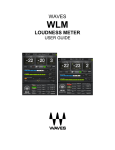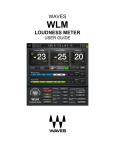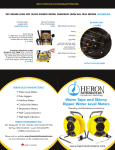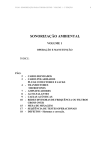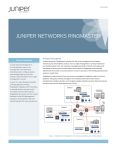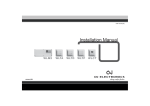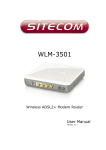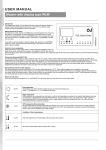Download WLM series water level meter operating instructions
Transcript
WLM series water level meter operating instructions GENERAL The WLM Series Water Level Meter is a self contained, portable instrument. This meter is used for measuring static water level in wells or small diameter samplers. The WLM is contructed of lightweight aluminum and machined solid plastic components to provide a more rugged contruction than injection melded plastic components. The electronics module can be removed so that the entire reel and tape can be cleaned and decontaminated. The tapes are marked in feet, 1/10 ft (black numbers) and 1/100 fi. graduations and meet international standards for accuracy, US GGG-T-106E (U.S.A.) and EEC CLASS II (Europe) Probes are constructed of stainless steel and teflon. OPERATION All units are equipped with a test button, so that the circuit and battery can be tested before beginning field work. Push and hold down the test button for several seconds to verify that the battery will be able to keep working in the field. A battery life of 2-3 years is normal, provided the buzzer and light are not on, Verify polarity, Although difficult, it is possible to insert the battery into the drawer incomectly, so please verify polarity. If the battery needs to be forced into the drawer it is probably backwards. During a pump test, the sensitivity knob can be fumed fully counterclockwise to turn the unit off. The WLM meters are designed for simple operation in the field, All meters are equipped with an external adjustment for water quality to provide faster water detects in very pure water. For very pure water (no dissolved solids) turn the external knob clockwise fo the 2 or 3 o'clock position, For very salty water, turn the knob counterclockwise to the 10 or 11 o'clock position. This prevents bridging which occurs when the probe being wet is detected as the probe being in water, Please note:distiled water cannot be detected at any setting, so avoid using the delonized water (distilled water) generally used in the cleaning process since the lons conduct the electric current that activates the circuit, MAINTENANCE AND STORAGE The meter should be stored with the tape and strain relief under very slight tension, just enough fo keep the tape from unwinding, Excessive tension will wear out the strain relief unnecessarily and prematurely. The probe can be stored without the need to clean it. When cleaning the probe do not use organic solvents. In the event lime or calcium deposits on the probe electrodes, remove the battery and soak the probe in water and vinegar, 2 parts water one part vinegar overnight. Since all units have a removable electronics module, the reel and tape assembly can be cleaned using full immersion (providing the electrical connector in the reel Is kept out to the water) or using water from a hose. PROBE OR CABLE REPLACEMENT Detalled directions are included with the new probe or tape. Generally the tape and probe wear out at the same rate and are replaced as a single assembly. TROUBLE SHOOTING CHART ‘What It's Doing Cause Remedy Meter does mot sound Battery k deod Install new battery. lt | uy Battery 5 nstalied incorrect. Check battery postion & polarfy. Sensitivity 15 sel too low. Adjust sensitivity. Tum knob clock wise and of make certain you ane not using de-ionized or distiled water Meter does not sound Water 5 too pure. Use tap water. Do not use delonizad when the probe 5 in of distilled water to test the meter. walet but works with Probe | — th fest bution Radic a. Gk Battery & almost dead, Replace battery. Meter sounds constantly — | Probe 8 diriy. Ol or dust s absorbing water & creating after being removed a pahof water to "bridge" one electrode from water. Probe is dirty fo the other resulting In a "wer” probe being detected as being in water-clean with hot soopy water, Sensitivity E set too high. Turn the water sensing knob Counter clockwise. Water is bridging the intemal test Remove the battery and dry the button or circuit board. (very une) | infernal components & circuit board. Meter does not sound The water has very low conductivity. | Increase the water sensitivy fully when the probe is in water Sidr ary bi on TAC Tel rio ei while taking readings ngland in 1-3 grams of sait into ! | Water is contaminated by Increase sensitivity or use the INT sobvents of hydrocarbons, hydrocarbon detector that allows the interface to be measured, Special Directions for Bottom Sensing Probe Attachment 1. Turn water sensitivity knob fully counterclockwise. Push test button, buzzer should not sound. 2. Insert probe into about 12 inches of water making certain the bottom steel pin is not touching the bottom of the test container. Turn sensitivity knob clockwise just until the buzzer sounds (corresponds to about the 8 AM position). This will usually correspond to the small black mark on the faceplate. 3. Lower probe until the bottom sensor touches the bottom of the vessel, the buzzer should turn off. If it does not, turn the water sensitivity counter clockwise in ¥%- ¥ hour increments, lifting the probe after each adjustment to see if it will still detect water. Calibrating Without Water Sample Available. 1. Follow step 1 2. Hold down the test button and turn sensitivity knob clockwise until the buzzer sounds. 3. It may be necessary to advance the black knob about 74-% an hour clockwise or until the beeping tone resumes when the probe is in low conductivity water. This should provide just enough sensitivity that the tone will stop once the piston covers the water sensing center electrode. It will only be necessary to make the above adjustment once unless the water s conductivity changes significantly.



